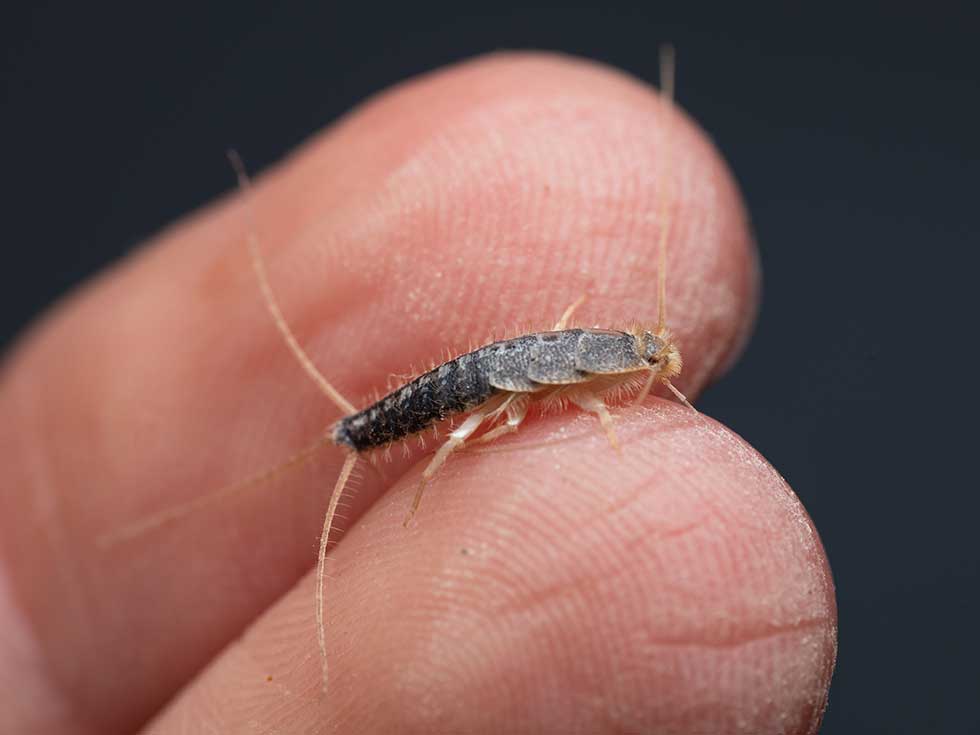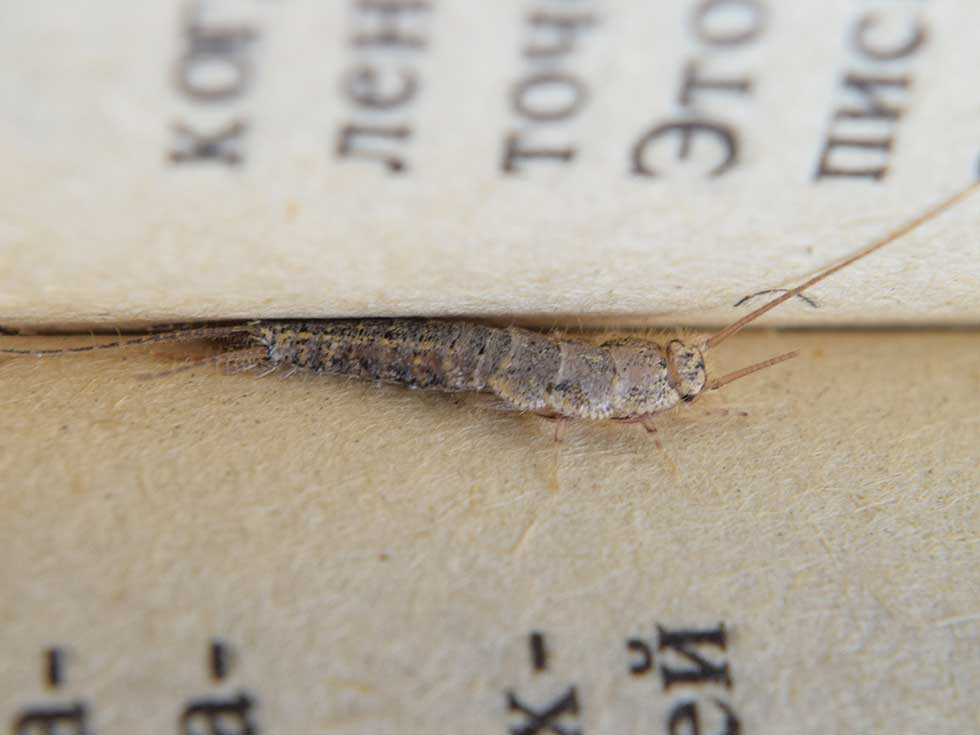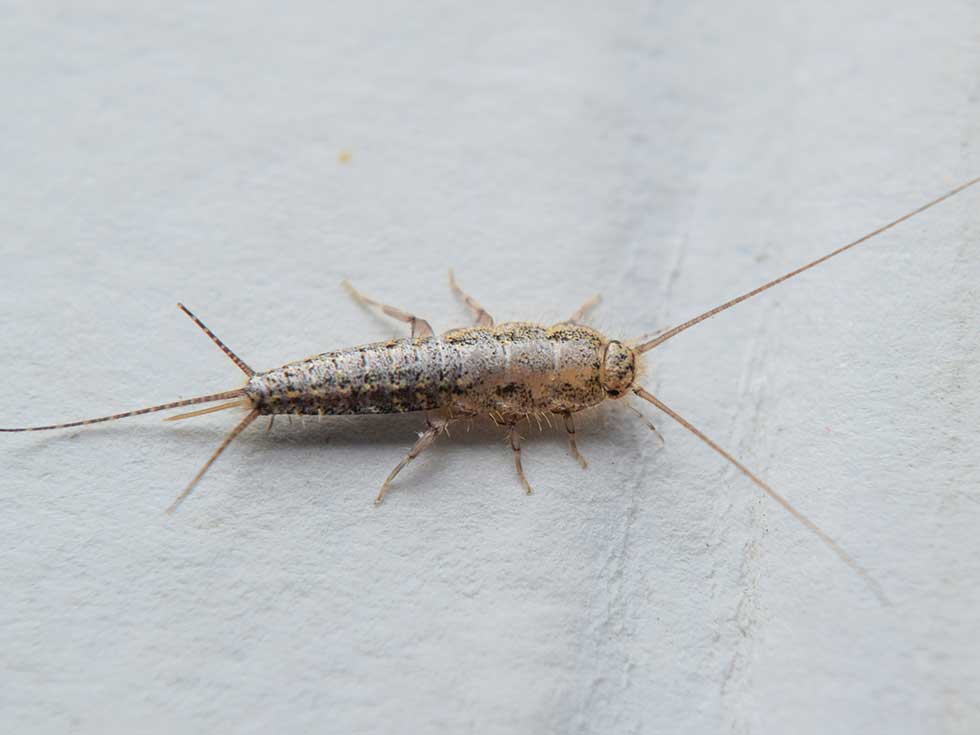The silverfish (also spelled silver-fish and also known as fish moth) is a discreet, humidity-seeking insect found in many Québec homes. While it is harmless to humans, it can still cause damage, especially when it infests a space in large numbers.
Discover how to identify silverfish, how to prevent their presence and eliminate them efficiently.
Are you worried about the presence of insects in your home? Contact an exterminator for a free estimate.
How to identify silverfish
The body of the silverfish is long and flat, and is covered by tiny scales that shine; this is what gives them the appearance of being covered in silver. Their slim silhouette ends with three long caudal bristles, and their head has two thin, flexible antennae.
This insect is known for its quick, undulating movements which resemble those of a swimming fish. Because of its shape and quick mobility, the silverfish is difficult to spot and catch, as it can easily squeeze into cracks, under baseboards and behind furniture.

Discreet but constant habits
The silverfish has a surprisingly long lifespan for an insect–it can live for up to 3 to 8 years. It reproduces progressively rather than all at once. During its entire life, it continuously lays small quantities of eggs. This type of reproduction spread out over many years allows it to discreetly take root, and is also what makes its elimination more complex.
So, if you see a large number of silverfish in your house, this means the infestation has been ongoing for quite some time.
Silverfish or firebrat?
The silverfish bears a close resemblance to the firebrat, another insect in the same family (Thermobia domestica). It can be easy to confuse the two because they both look and move in similar ways. However, a few differences allow to distinguish one from the other.
The silverfish has a shiny, silver body, whereas the firebrat’s body is mostly brownish with dark spots. Additionally, silverfish prefer cool and damp spaces like bathrooms and basements. Firebrats, on the other hand, are found in warmer areas of a building, such as attics or near electrical appliances.
If you have discovered a small silvery insect crawling in the bathroom at night, it’s probably a silverfish.
Insects that like moisture
Silverfish are nocturnal insects that are especially attracted to dark, damp and warm spaces. They are often found in bathrooms, basements, kitchens and laundry rooms, where they can easily hide in cracks, under baseboards or behind furniture.
They can also be attracted to closets, bookshelves and storage boxes, especially when the ambient humidity reaches over 75%. It’s even possible to find silverfish in a bed.
Eating habits
Silverfish are detritivorous insects, meaning they feed mostly on materials that are rich in starch and cellulose. Their diet includes:
- paper and cardboard (books, old newspapers, wallpaper)
- glue in books and book bindings
- natural textiles (cotton, linen, silk)
- dry foods (flour, cereals, sugar)
- mould and organic residue
Capable of surviving several months without feeding, silverfish crawl around discreetly in search of food and sometimes leave behind them crumbs of things they’ve chewed on or small holes in paper and textiles.
Why have silverfish taken up residence in my house?
If you notice silverfish in your home, it’s because it offers them conditions that are ideal for their survival. These insects seek three essential factors in order to thrive:
- high humidity
- dark hiding places
- accessible food (paper, glue, textiles, food crumbs)

Are silverfish dangerous?
Silverfish are harmless to humans. They don’t sting, don’t transmit disease and do not represent any direct threat. They are nonetheless still considered as pests. A significant infestation can be a source of inconvenience as it could damage books, wallpapers and textiles.
Its presence can also be a sign of a moisture problem in the building, which can lead to the growth of mould and attract other harmful parasites.
Which treatment can be used to get rid of silverfish in your home?
Getting rid of silverfish requires a strategy that combines prevention, trapping and targeted treatment. Here are a few solutions to limit their presence.
Traps: efficiently capture silverfish
Silverfish move around mostly at night, which makes their elimination difficult. Here are a few examples of traps that are simple to use:
- place bait (sugar or flour) at the bottom of a glass jar which you have covered with rough adhesive tape like masking tape. The silverfish will thus be able to climb into the jar, but be unable to climb back out because of the smooth glass surface inside the jar
- create traps by installing double-sided adhesive tape along baseboards and on dark corners where they circulate
- roll up a slightly damp newspaper and leave it in place all night. In the morning, throw it away without unrolling it, as the silverfish will be hiding inside
Using chemicals to eliminate silverfish
If you’re facing a significant infestation of silverfish, it may be necessary to use insecticides or other chemicals to get rid of them, such as:
- diatomaceous earth
- powder containing boric acid
- pesticides sold in supermarkets (these should be used with extreme caution, especially if children or pets are using the same space)
Does white vinegar work?
White vinegar is often recommended as a natural repulsive agent against silverfish. While it might temporarily disturb them, it does not eliminate them and will not stop them from coming back. In order for a vinegar treatment to be efficient, it should be combined with other methods like lowering ambient humidity and using traps.
Using natural predators of silverfish
In nature, several insects and arachnids eat silverfish, notably:
- spiders
- various centipedes
However, counting on these predators to stop an infestation of silverfish is not an efficient solution indoors.
What measures can you take to prevent silverfish from coming back?
To stop silverfish from making a comeback into your home, it’s essential to remove the conditions that attracted them there in the first place. Here are a few prevention tips that work:
- lower ambient humidity by using a dehumidifier or through regular ventilation of damp areas (bathrooms, basements, laundry rooms)
- eliminate hiding places by sealing cracks, gaps and baseboards, and avoid keeping stacks of storage boxes and paper
- limit food sources by storing documents and books in airtight containers, and avoid leaving crumbs or food residue out in the open
- vacuum frequently in order to clean any dark, out-of-the-way corners and under furniture to remove any insect eggs and droppings or debris
Need help identifying and eliminating silverfish?
Spotting a single silverfish is not necessarily something to be concerned about, but their presence in large numbers may indicate that a moisture problem is developing or that an infestation is in progress. If you have any doubts about identifying this insect, or if you notice a significant increase in their numbers, it is recommended to act rapidly.
The experts at Avalanche Extermination can help you confirm the presence of silverfish, assess the scope of the problem and take measures to implement an efficient treatment to protect your home.
Contact a silverfish exterminator for an inspection and customized solutions!

